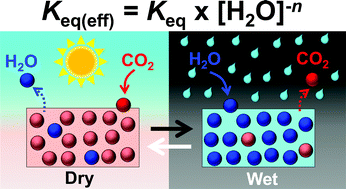Isotherm model for moisture-controlled CO2 sorption†
Abstract
Moisture-controlled sorption of CO2, the basis for moisture-swing CO2 capture from air, is a novel phenomenon observed in strong-base anion exchange materials. Prior research has shown that Langmuir isotherms provide an approximate fit to moisture-controlled CO2 sorption isotherm data. However, this fit still lacks a governing equation derived from an analytic model. In this paper, we derive an analytic form for an isotherm equation from a bottom-up approach, starting with a fundamental theory for an alkali liquid. In the range of interest relevant to CO2 capture from air, an isotherm equation for an alkali liquid reduces to a simple analytic form with a single parameter, Keq. In the limit Keq ≫ 1, a 2nd order approximation simplifies to a Langmuir isotherm that, however, deviates from experimental data. The isotherm theory for an alkali liquid has been generalized to a strong-base anion exchange material. In a strong-base anion exchange material, water concentration inside a sorbent, [H2O], is not large enough to be regarded as constant, which allows us to extend Keq to Keq(AEM)eff = Keq(AEM) × [H2O]−n according to the law of mass action. The final isotherm formula has been validated by experimental data from the literature. For a moisture-controlled CO2 sorbent, Keq(AEM)eff varies significantly with moisture content of the sorbent. Depending on moisture level, the observed Keq(AEM)eff in a specific sorbent ranges from a few times to a few thousand times the value of Keq of a 2 mol L−1 alkali liquid.

- This article is part of the themed collection: 2022 PCCP HOT Articles


 Please wait while we load your content...
Please wait while we load your content...